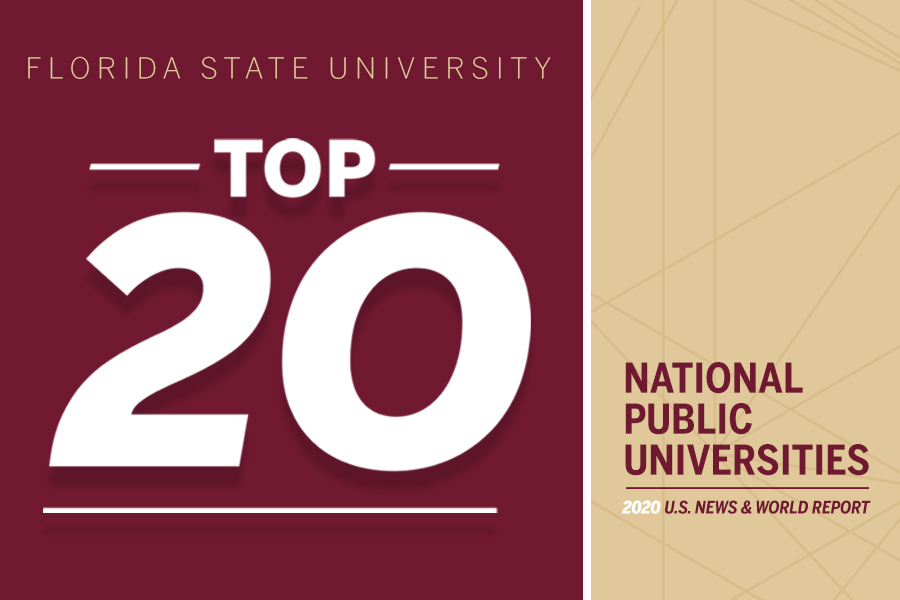Florida State University Joins Nation's Top 20

U.S. News & World Report Ranks FSU No. 18 Among Public Universities
TALLAHASSEE, Fla. — Florida State University soared eight spots to No. 18 among national public universities in the latest U.S. News & World Report rankings, meeting and well exceeding its goal of joining the Top 25.
It’s the greatest single-year improvement in university history.
The rankings appear in U.S. News & World Report’s “Best Colleges 2020” guidebook.
“It’s an incredible accomplishment for Florida State University,” said President John Thrasher. “The credit goes to so many people — our faculty, our staff, and certainly, our great students. I couldn’t be prouder.”
FSU has risen 25 spots among public universities since placing No. 43 in 2016. FSU moved up to No. 38 on the 2017 list and then to No. 33 on the 2018 list. Last year, FSU ranked No. 26 among public universities.
Florida State’s rise was sparked by its designation as a preeminent university by the state legislature in 2013.
“The Florida Legislature believed in us, and they believed in our plan to get there,” Thrasher said. “They asked us to be a Top 25 university — we’re now a Top 20 university. I think they’ll be pleased with the results, and I hope it will give them impetus to help us continue this success.”
While reaching the Top 20 is a validation of its national prominence, Florida State’s sole focus isn’t rankings.
Provost and Executive Vice President for Academic Affairs Sally McRorie points to the university’s emphasis on student success as the primary factor in FSU’s rapid ascent in the rankings over the past few years.
“Student success is at the heart of everything we do here,” McRorie said. “I always say that every decision comes down to what is best for our students. Then, it becomes a fairly easy decision to make.”
For example, FSU hired 125 new faculty last fall to improve class size and research. Now, more than 50 percent of FSU’s classes are smaller than 20 students.
“We know from the national data that one of the most important things for long-lasting lifetime success and sense of well-being for college graduates is to have had a positive mentoring relationship with a faculty member,” McRorie said. “We know that in our smaller classes our students learn better, and our faculty have a better opportunity to have an impact on those students.”
A number of related factors also contributed to FSU’s ranking, such as improvements in graduation rates, student-faculty ratio and percentage of full-time faculty.
FSU’s average six-year graduation rate increased to 80.5 percent, up 3 percentage points in three years. FSU also outperformed its predicted graduation rate by 13 percentage points. The university ranks No. 11 among publics when comparing the actual graduation rate against the predicted rate, which U.S. News calculates based on the university’s resources and student profile.
In addition, Florida State moved up five spots to No. 17 among public universities for graduation rate of Pell Grant students.
Florida State’s four-year graduation rate of 72 percent ranks among the Top 10 public universities in the country and is No. 1 in Florida.
“You can talk about student success but to achieve a four-year graduation rate that is the best in the state of Florida and one of the best in America, you have to use your resources for counseling, for advisers, for giving students the opportunity to understand the right pathway to get their degree in four years,” Thrasher said. “Sally McRorie and her team have done that.”
FSU also moved up in peer assessment ratings, a survey of the nation’s presidents, provosts and enrollment managers.
“We haven’t had a lot of national attention until recent years, and it’s really gratifying as provost to know that other universities recognize the quality of educational opportunities we have at Florida State,” McRorie said.
FSU improved its student-faculty ratio to 21-to-1.
“I can’t say enough about our faculty,” McRorie said. “Our faculty are working really hard to practice good teaching methodologies and to learn how to teach in a new and flexible way that appeals to students and makes active learning happen.”
Thrasher agreed.
“You cannot do this without outstanding faculty,” Thrasher said. “You can’t be a top-tier university without having great research scientists and good teachers who come in every single day and care about their students. That’s what we’ve invested in.”
Florida State also rose one spot to No. 7 in the undergraduate alumni giving metric.
FSU shares the No. 18 spot with three other public universities: Penn State University, Purdue University and the University of Pittsburgh.
“The number is significant in the sense that this is a university that stands out among all the public universities in America,” Thrasher said. “For that reason, it will help us continue to attract outstanding faculty and students.”
Among all national universities, including private universities, FSU ranked 57th, up from 70th last year. The University of Miami, a private institution, joins FSU, Penn State, Purdue and Pitt at No. 57 in the overall rankings. The national universities category comprises 381 institutions (208 public, 172 private and 1 proprietary) that offer a wide range of undergraduate majors as well as master’s and doctoral degrees.
U.S. News & World Report determines its national university rankings based on these factors: graduation and retention rates (22 percent); expert opinion, i.e. peer assessment (20 percent); faculty resources (20 percent); student excellence (10 percent); financial resources (10 percent); graduation rate performance (8 percent); social mobility (5 percent); and alumni giving (5 percent).



